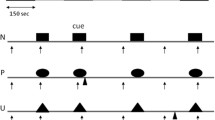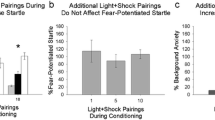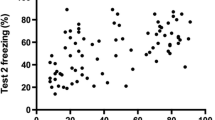Abstract
Preclinical studies have suggested the acoustic startle reflex (ASR) may be a useful animal model to investigate the neurochemical basis of anxiety and fear states. This work has revealed that the anxiogenic alpha-2 receptor antagonist, yohimbine, increases the amplitude of the ASR in laboratory animals. The present investigation evaluated the effects of yohimbine on the ASR in healthy subjects. Seven healthy subjects received IV yohimbine (0.4 mg/kg) or saline placebo on two separate days in a randomized double blind placebo control design. A trial of 2 tone frequencies with varied intensity (90, 96, 102, 108, 114 dB) white noise, instantaneous rise time, was delivered binaurally through headphones. Tones were delivered every 25–60 sec, for a 30 ms duration. Startle testing was done 80 minutes post infusion and lasted 15–20 minutes. Sign rank testing indicated yohimbine caused an overall increase in startle amplitude, as well as significant augmentation of startle amplitude at 96, 102, 108, 114 decibels but not at the 90 dB intensity. Sign rank tests indicated a significant reduction of startle latency by yohimbine at only the 96 dB intensity. Significant correlations were observed between startle and peak anxiety, startle and plasma MHPG, peak anxiety and plasma MHPG. This study demonstrates in healthy human subjects an excitatory effect of yohimbine on the mangnitude of the ASR and a decrease in its latency. In the context of the key role of this reflex in the alarm response, this finding adds to the array of documented behavioral, biochemical and cardiovascular effects of yohimbine in humans which support the relationship between increased noradrenergic function and anxiety states.
Similar content being viewed by others
References
Brown JS, Kalish HI, Farbert IE (1951) Conditioned fear as revealed by magnitude of startle response to an auditory stimulus. J Exp Psychol 43:317–328
Butler RW, Braff DL, Rausch JL, Jenkins MA, Sprock J, Geyer MA (1990) Physiological evidence of exaggerated startle response in a subgroup of Vietnam veterans with combat related PTSD. Am J Psychiatry 147:1308–1312
Cedarbaum JM, Aghajanian GK (1976) Noradrenergic neurons of the locus coeruleus: inhibition by epinephrine and activation by the alpha-antagonist piperoxane, Brain Res 112:413–419
Charney DS, Heninger GR, Breier A (1984) Noradrenergic function in panic anxiety: effects of yohimbine in healthy subjects and patients with agoraphobia and panic disorder. Arch Gen Psychiatry 41:751–763
Charney DS, Woods SW, Goodman WK, Heninger GR (1987) Neurological mechanisms of panic anxiety: biochemical and behavioral correlates of yohimbine-induced panic attacks. Am J Psychiatry 144:1030–1036
Cook EW, Hawk LW, Davis TL, Stevenson VE (1991) Emotional dysfunction and affective modulation of startle. J Abnorm Psychol 100:5–13
Davis M (1979) Diazepam and flurazepam: effects on conditioned fear as measured by the potentiated startle paradigm. Psychopharmacology 62:1–7
Davis M (1984) The mamalian startle response. In: Eaton RC (ed) Neural mechanisms of startle behavior. Plenum Press, New York, pp 187–351
Davis M, Astrachan B (1978) Conditioned fear and startle magnitude: effects of different footshock or backshock intensities. J Exp Psychol [Anim Behav Proc] 4:95–103
Davis M, Redmond Jr E, Barban J (1979) Noradrenergic agonists and antagonists: effects on conditioned fear as measured by the potentiated startle paradigm. Psychopharmacology 65:111–118
Davis M, Hitchcock JM, Rosen JB (1988) Anxiety and the amygdala: pharmacological and anatomical analysis of the fear-potentiated startle paradigm. In Bower GH (ed) The psychology of learning and motivation, vol 21. Academic Press, New York, pp 263–305
Dekirmenjian H, Maas JW (1974) MHPG in plasma. Clin Chem Acta 52:203–208
Grillon C, Ameli R, Woods S, Merikangas K, Davis M (1992) Fear potentiated startle in humans: effects of anticipatory anxiety on the acoustic blink reflex. Psychophysiology (in press)
Huzen TH, Slangen JL (1989) Effects of midazolam, DMCM and lindane on potentiated startle in the rat. Psychopharmacology 99:362–365
Kehne JH, Davis M (1985) Central noradrenergic involvement in yohimbine excitation of acoustic startle: effects of DSP4 and 6-OHDA. Brain Res 330:32–41
Kehne JH, Cassela JV, Davis M (1988) Anxiolytic effects of buspirone and gepirone in the fear-potentiated startle paradigm. Psychopharmacology 94:813
Krystal JH et al. (1989) Neurobiological aspects of PTSD: review of clinical and preclinical studies. Behav Ther 20:177–198
Mass JW, Hattox SE, Roth RH (1976) The determination of a brain arteriovenous difference for 3-methoxy-4-hydroxyphenylethy-leneglycol (MHPG). Brain Res 118:167–174
McCall RB, Aghajanian GK (1979) Denervation supersensitivity to serotonin in the facial nucleus. Neuroscience 4:1501–1510
Peskind ER, Veith RC, Dorsa DM, Gumbrecht G, Raskind MA (1989) Yohimbine increases cerebrospinal fluid and plasma norepinephrine but not arginine vasopressin in humans. Neuroendocrinology 50:286–291
Ross LE (1961) Conditioned fear as a function of CS-UCS and probe stimulus intervals. J Exp Psychol 61:265–273
Southwick SM, et al. (1991) Yohimbine andm-chloro-phenyl-piperazine in PTSD. New Research Abstracts. American Psychiatric Assoc. 144th Annual Meeting, New Orleans, La, pp 131–132
Spence KW, Runquist WN (1958) Temporal effects of conditioned fear on the eyelid reflex. J Exp Psychol 55:613–616
Svenson TH, Usdin T (1978) Feedback inhibition of brain noradrenaline neurons by tricyclics: alpha-receptor medication. Sciencen 202:1089–1091
Vrana SR, Spence EL, Lang PJ (1988) The startle probe response: a new measure of emotion? J Abnorm Psychol 97:487–491
White SR, Neuman RS (1980) Facilitation of spinal motorneurone excitability by 5-hydroxytryptamine and noradrenaline. Brain Res 188:119–128
Author information
Authors and Affiliations
Rights and permissions
About this article
Cite this article
Morgan, C.A., Southwick, S.M., Grillon, C. et al. Yohimbine — facilitated acoustic startle reflex in humans. Psychopharmacology 110, 342–346 (1993). https://doi.org/10.1007/BF02251291
Received:
Revised:
Issue Date:
DOI: https://doi.org/10.1007/BF02251291




